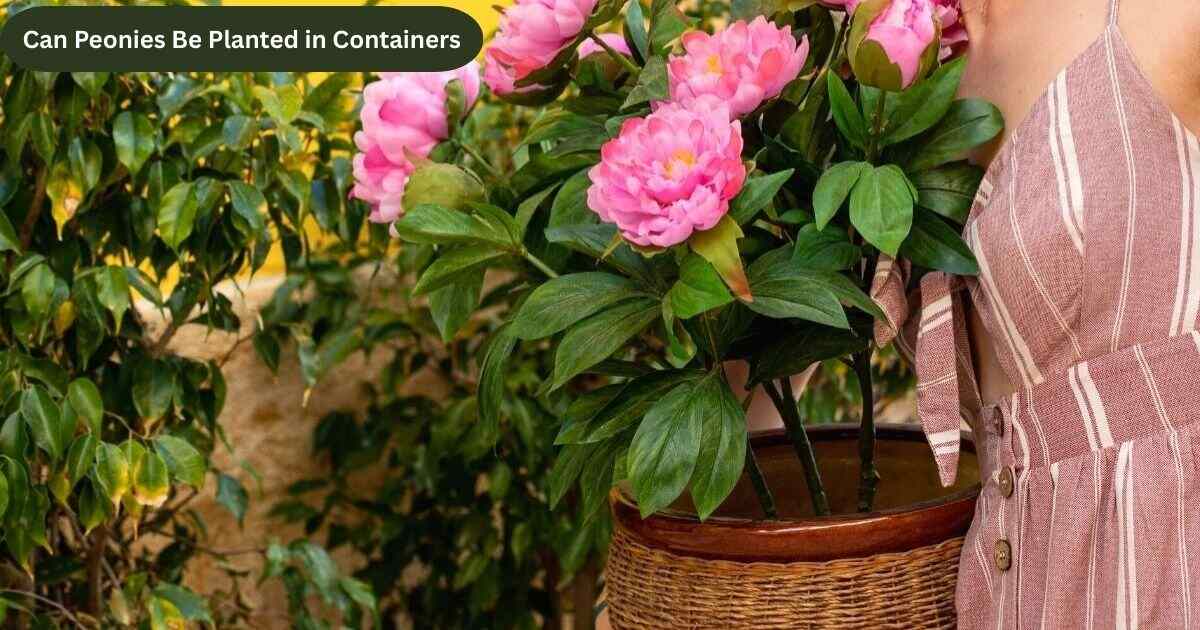Peonies are a beloved flower known for their vibrant blooms and delightful fragrance, making them a popular choice for gardens. While traditionally planted in the ground, many gardeners are curious about growing peonies in containers. This is especially true for those with limited space, like apartment dwellers or people with small patios.
Growing peonies in containers can be a rewarding experience if you provide the right conditions. With the proper pot size, drainage, and care, these beautiful flowers can thrive even in small spaces. In this article, we’ll guide you through the essentials of growing peonies in containers, ensuring you can enjoy their beauty year-round.
Understanding Peony Growth Requirements
Peonies thrive in well-drained soil, full sun, and cold winters, which help them go through their dormant period. These growth conditions are essential for ensuring healthy blooms year after year. In a container, meeting these needs becomes a little trickier, but it’s entirely possible with the right preparation. Peonies need a minimum of six hours of direct sunlight per day to thrive, making sun exposure one of the most crucial factors when growing them in pots.
The size of the container is equally important. Peonies have deep roots, so choosing a sufficiently large pot is vital. The container should be at least 18 inches wide and 24 inches deep to accommodate the plant’s root system. If the pot is too small, the plant will become root-bound, limiting its ability to grow and produce flowers. Ensuring proper drainage in the container will also help prevent waterlogging, which can lead to root rot.
Choosing the Right Peony Varieties for Containers
Not all peony varieties are ideal for container growth, so selecting the right type of peony is crucial for success. Tree peonies and herbaceous peonies are the two main types to consider. Tree peonies are generally more suited for containers due to their smaller root systems and compact growth habit. They tend to be more manageable and don’t require as much space as herbaceous peonies.
Herbaceous peonies, on the other hand, can also be grown in containers but typically need larger pots to accommodate their extensive root systems. In addition, herbaceous peonies die back to the ground each winter, which may lead to a slower recovery in the following spring if the pot doesn’t provide enough insulation. Both types can produce beautiful flowers, but tree peonies may offer a more practical choice for container gardening.
Selecting the Right Container Material
The material of your container can impact the health of your peony plant. Containers made from materials like clay, ceramic, or terracotta provide excellent drainage and airflow, allowing the roots to breathe. However, these materials can dry out quickly in hot weather, requiring more frequent watering. If you live in a warmer climate or a dry area, consider using plastic or resin containers, which retain moisture better but still offer drainage.
Another factor to consider is the weight of the container. Peonies, especially tree peonies, can grow quite tall and heavy, so ensure the container is sturdy enough to support the plant. A heavier pot will also prevent the plant from tipping over in strong winds. Make sure the container is large enough to allow for the plant’s growth while providing proper air circulation and water drainage.
Preparing the Container for Planting
Before planting your peonies in the container, proper preparation is essential for the plant’s health and success. Start by placing a layer of gravel or small stones at the bottom of the pot to improve drainage. This will prevent the soil from becoming waterlogged, which can cause root rot. A good quality potting mix should be used, as it will provide the necessary nutrients and structure for the peonies’ growth.
After adding the potting mix, leave enough space at the top of the container to plant your peony. When planting, ensure that the peony’s eyes (buds) are no more than two inches below the soil surface. Planting too deep can prevent the plant from emerging, while planting too shallow can expose the roots to the elements. After planting, water the peony thoroughly to help settle the soil and encourage root growth.
Caring for Peonies in Containers
Caring for peonies in containers involves regular attention to their watering, feeding, and overall health. Peonies generally require consistent moisture but dislike being overwatered. Ensure the soil remains moist but not soggy. During the growing season, water the peonies deeply once a week, especially if rainfall is insufficient. In the winter months, reduce watering since the plant will be dormant.
Fertilizing peonies in containers is also important to encourage healthy growth and blooms. Use a balanced, slow-release fertilizer in early spring when the plant starts to emerge from dormancy. Avoid using high-nitrogen fertilizers, as these can promote excessive foliage growth at the expense of flowers. During the blooming period, peonies generally do not need additional feeding, but a light application of fertilizer in late summer can help strengthen the plant for the following year.
Managing Temperature and Winter Care
Peonies require a cold period to bloom properly, making winter care in containers a vital consideration. In regions with cold winters, it’s essential to protect the roots of peonies from freezing temperatures. You can do this by moving the container to a sheltered location, such as a garage, porch, or basement. If bringing the container indoors is not an option, insulate the pot with burlap or garden fleece to provide extra protection.
Alternatively, you can sink the container into the ground, burying it up to the rim to protect the roots from freezing. This method helps regulate the temperature and prevents the plant from experiencing sudden temperature fluctuations. In warmer climates where freezing is not an issue, simply reduce watering and allow the plant to go dormant naturally.
Pruning and Deadheading Peonies in Containers
Pruning and deadheading are essential maintenance tasks that help promote healthy growth and encourage more blooms. After the peony has finished flowering, remove the spent flowers to prevent the plant from wasting energy on seed production. This process, known as deadheading, will encourage the plant to direct its energy toward building stronger roots for the next growing season.
Pruning should be done in late fall or early spring, once the plant has gone dormant. Cut back the stems to just above the ground level, removing any dead or damaged foliage. If the container has become overcrowded or the plant is growing too large, consider thinning out the roots or dividing the plant. This will help maintain the plant’s health and prevent it from becoming root-bound in its pot.
Common Problems and Solutions for Container-Grown Peonies
Peonies in containers can face certain challenges, such as pests, diseases, or poor growth. One common problem is root rot, which often occurs when the soil remains too moist or doesn’t drain properly. To prevent this, ensure that your container has adequate drainage holes and that the potting mix is well-draining. Overwatering can also lead to other issues like fungal infections or mold growth, so it’s essential to monitor the soil moisture carefully.
Pests like aphids or ants may also target peonies, especially during the blooming season. If you notice an infestation, treat the plant with insecticidal soap or neem oil to control the problem. Regularly inspecting the plant for pests and diseases will help keep your peonies healthy and vibrant throughout the growing season. With proper care and attention, container-grown peonies can thrive and reward you with stunning flowers year after year.
Read More: Can Peonies Be Grown in a Pot
Conclusion
In conclusion, growing peonies in containers is a rewarding and feasible option for those with limited space or specific gardening conditions. By choosing the right variety, ensuring proper drainage, and providing adequate sunlight and care, peonies can thrive in pots just as well as they do in the ground.
With the right preparation for winter and attention to watering and feeding, container-grown peonies can offer stunning blooms season after season. Whether you live in an apartment or have a small balcony, peonies in containers bring the beauty and fragrance of these timeless flowers into any space.
FAQ’s
Can peonies be grown in containers?
Yes, peonies can be successfully grown in containers with the right care and conditions.
What size container is needed for peonies?
Peonies need a container that is at least 18 inches wide and 24 inches deep.
Do peonies need full sunlight in containers?
Yes, peonies require a minimum of six hours of direct sunlight per day to thrive.
How often should I water peonies in containers?
Water peonies deeply once a week, ensuring the soil remains moist but not soggy.
Can I leave peonies in containers over the winter?
Yes, but ensure the container is protected from freezing temperatures, either by bringing it inside or insulating it.









